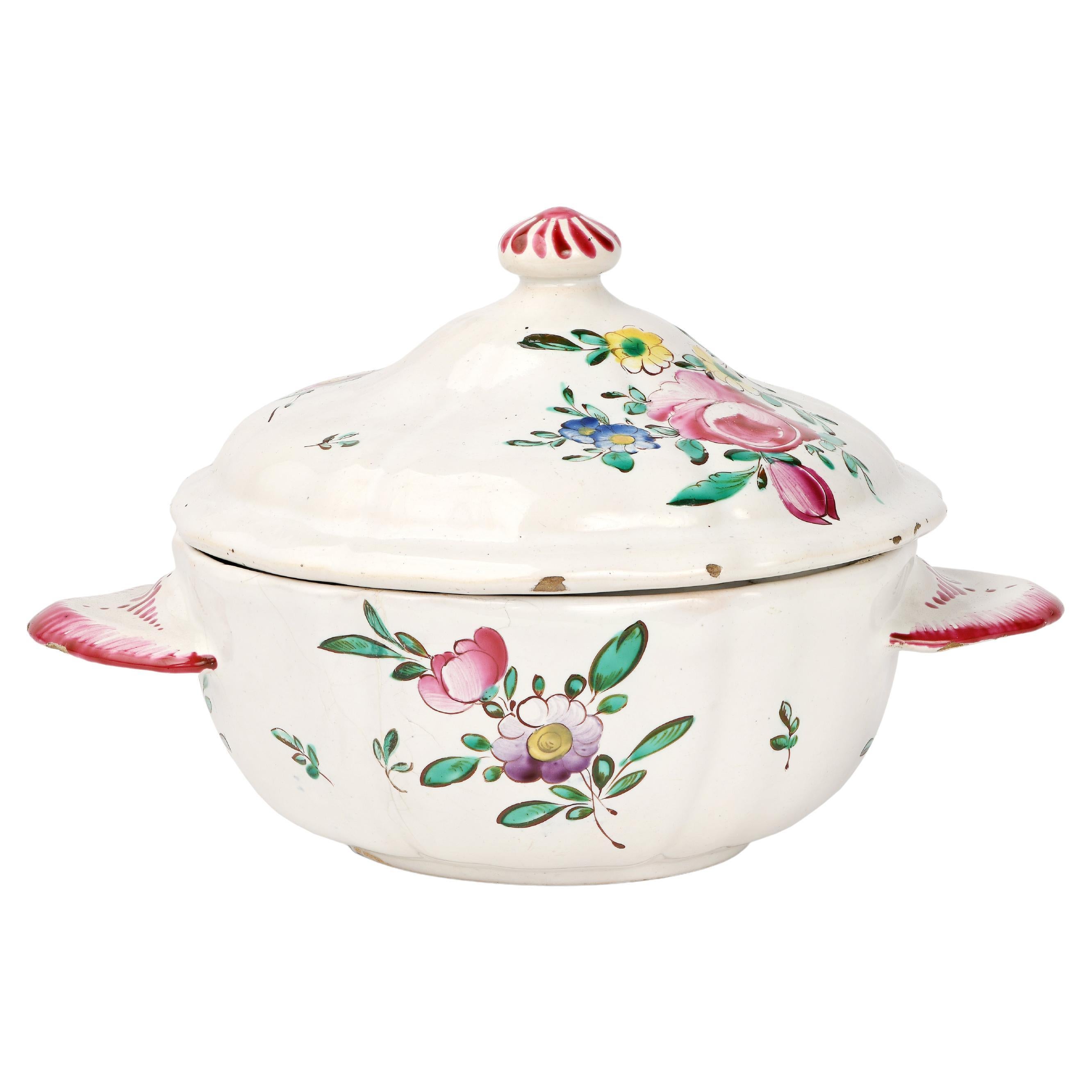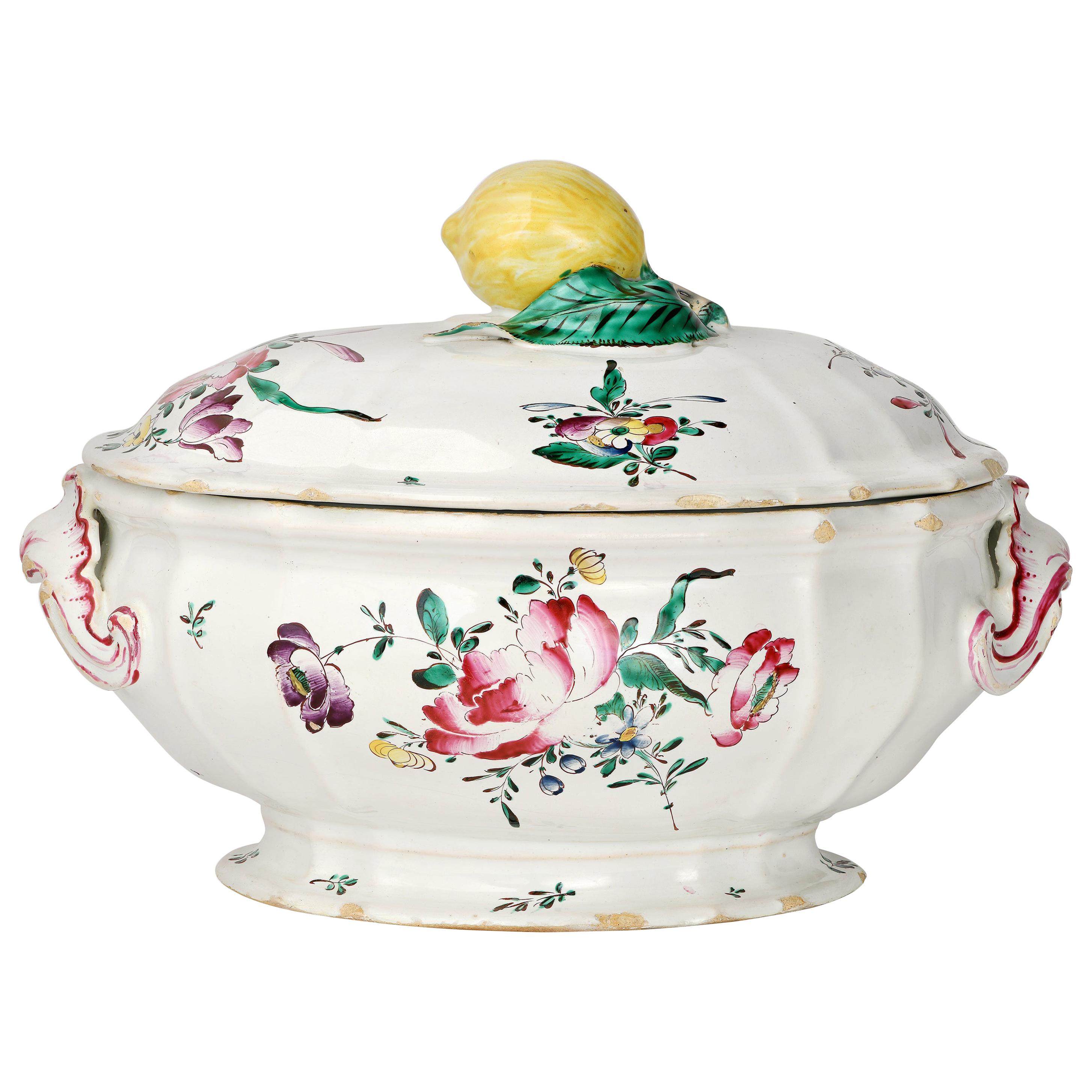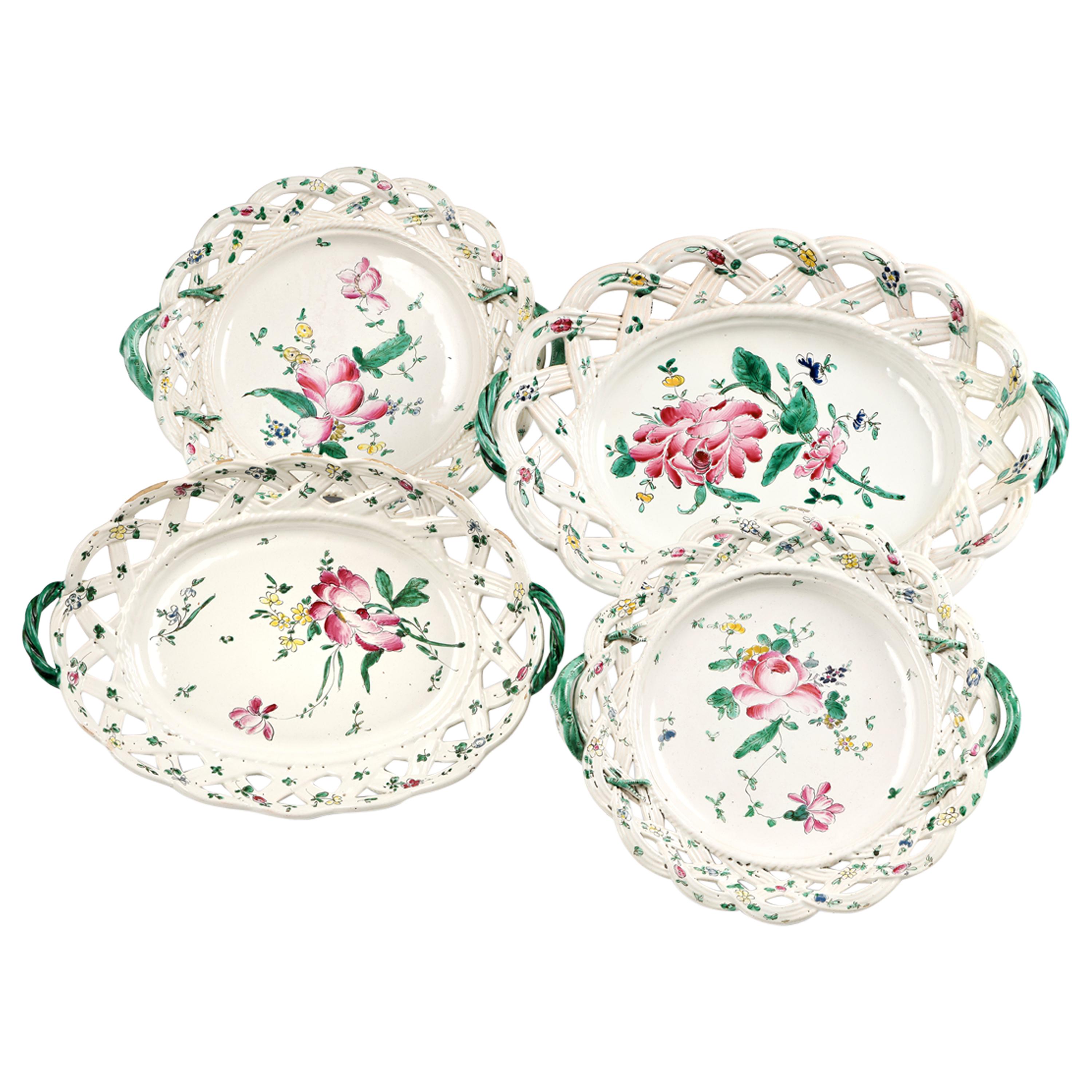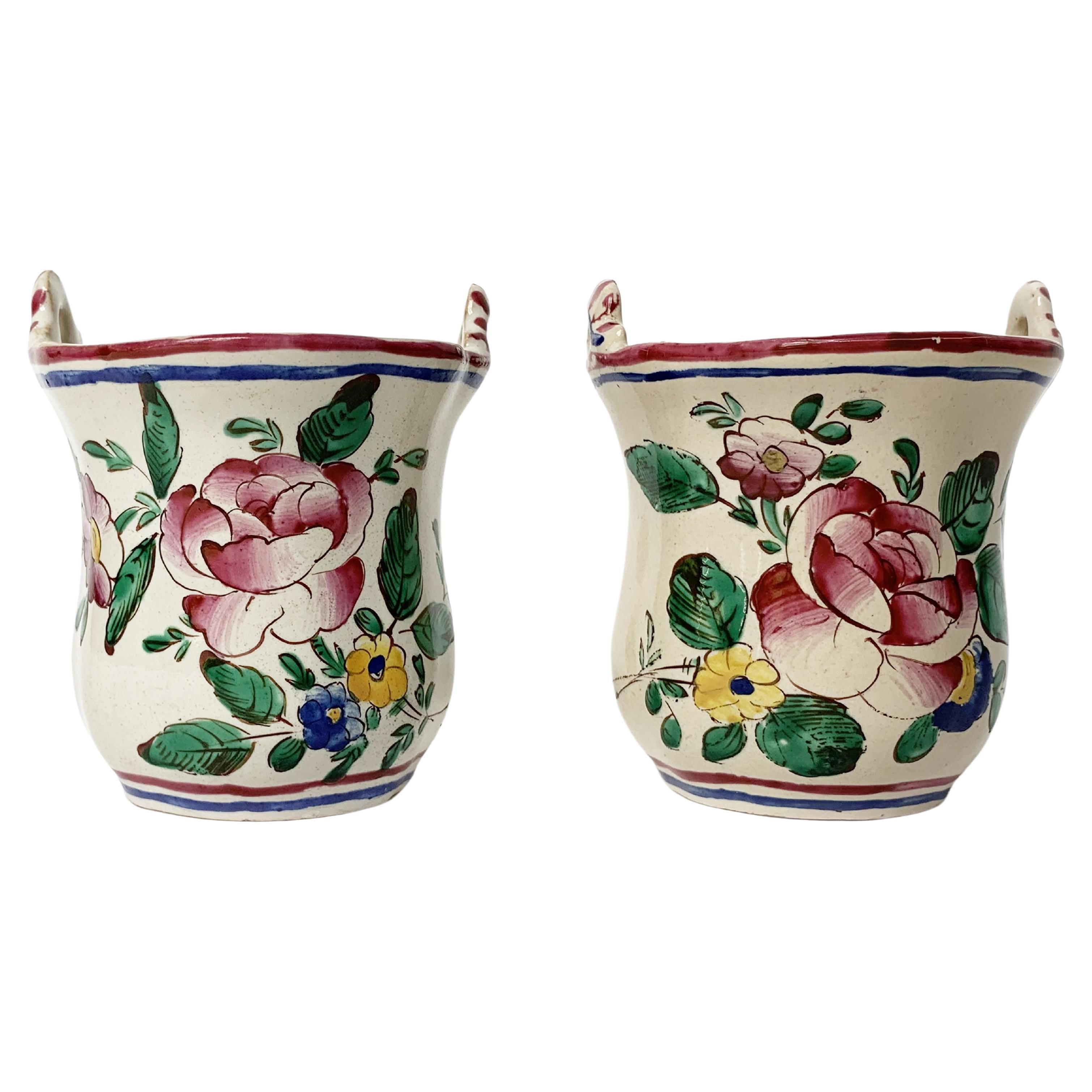Items Similar to Ancient Italian Assortment Coffe Pot and Cups, Lodi, Circa 1765-1770
Video Loading
Want more images or videos?
Request additional images or videos from the seller
1 of 20
Ancient Italian Assortment Coffe Pot and Cups, Lodi, Circa 1765-1770
About the Item
A coffee pot and two cups with saucers
Antonio Ferretti Manufacture
Lodi, Circa 1765-1770
Maiolica polychrome decorated “a piccolo fuoco” (third fire).
They measure:
coffee pot: 9.64 in height x 6.69 x 5.51 (24.5 cm x 17 x 14); ); 1.16 lb (528 g)
cups:
a) 2.75 in height (7 cm); saucer diameter 4.33 in (11 cm); 0,357 lb (162 g)
b) 2.75 in height (7 cm); saucer diameter 4.33 in (11 cm); 0,372 lb (169 g)
State of conservation: the cups are intact. The coffee pot is intact except for a marked chip on the foot in the back and two chips on the edge of the lid, which also has a glued grip without touch-ups to the paint. Slight chipping from use to the internal stop circle of the lid.
The coffeepot, with a ribbed, enlarged and bellied pyriform body, rests on a slightly everted flat foot and has a rather pronounced beaked pourer. The upper portion of the handle is curved in a C-shape whereas the lower portion is another C-shape curving in the opposite direction. The coffee pot has a raised and cusped lid surmounted by a tall and slightly twisted knob.
The polychrome decoration, carried out “a piccolo fuoco” (third fire), shows, on the front under the spout, a composite bouquet of flowers with small rosettes and spring flowers from which some thin stems branch off supporting minute buds. Some scattered florets and secondary bouquets scattered along the body and on the lid complete the decoration. The handle is lined with purple, while the rim, the lid knob and the spout are highlighted with a touch of gold. Under the foot there is a dark green brushstroke - “chiodo”(nail) - to indicate the decoration to be created in the process.
The coffee pot is a rather rare and typical example of high “a piccolo fuoco” (third fire) production, of which few known examples of comparison have been made (M. L. Gelmini, in Maioliche lodigiane del '700, cat. mostra Lodi, Milano 1995 p. 147 n. 56 without lid; the shape is perfectly comparable to the specimen decorated in green monochrome on p. 187 n. 226).
The cups have a slightly ribbed circular body and a slightly raised disc foot, with a tubular handle woven like a branch. The saucer is circular, with a smooth edge and a disc-shaped foot with a vertical brim. The rim of both cups and plates is highlighted with gold. The decoration known as “a fiori fini“ shows on the front of the cup a) a bunch of flowers, with the rose and various flowers as well as some flowering branches repeated, in a more contained and decentralized version, on the saucer. On the second cup b) the decoration is distinguished by the presence of a multi-petal flower, probably a marigold or a marzolino flower, and small florets. This decoration with small flowers, painted with great skill in the Ferretti factory, constitutes, along with the other rare examples of comparison (M. L. Gelmini, Maioliche lodigiane del ‘700, Milano 1995, p. 146 nn. 154-155), a poignant example of the high production level achieved, in some ways comparable to German porcelain models.
This decorative style represented a strong point of the Lodi factory, which established itself thanks to the vivid nature of the colors made possible by the introduction of a new technique perfected by Paul Hannong in Strasbourg and later introduced by Antonio Ferretti to Italy. The production process, called “piccolo fuoco” (third fire), allowed the use of a greater number of colors than in the past; in particular, the purple of Cassius, a red made from gold chloride, was introduced. Its use allowed for many more tones and shades, from pink to purple.
Just the aforementioned introduction in 1760 of the innovative “a piccolo fuoco” (third fire) processing, which, expanding the ornamental repertoire with Saxon-inspired floral themes, was able to commercially compete with the German porcelains that had one of its most renowned offerings in the naturalistic Deutsche Blumen. Antonio Ferretti understood and promoted this technique and this decoration, proposing it in a fresher and more corrective version.
Bibliography:
C. Baroni, Storia delle ceramiche nel Lodigiano, in Archivio storico per la città e i comuni del circondario e della diocesi di Lodi, XXXIV (1915), pp. 118, 124, 142; XXXV (1916), pp. 5-8;
C. Baroni, La maiolica antica di Lodi, in Archivio storico lombardo, LVIII (1931), pp. 453-455;
L. Ciboldi, La maiolica lodigiana, in Archivio storico lodigiano, LXXX (1953), pp. 25 sgg.;
S. Levy, Maioliche settecentesche lombarde e venete, Milano 1962, pp. 17 sgg.; per l’esemplare qui presentato idem, tav XXIX
A. Novasconi - S. Ferrari - S. Corvi, La ceramica lodigiana, Lodi 1964, ad Indicem; Maioliche di Lodi, Milano e Pavia (cat.), Milano 1964, p. 229;
O. Ferrari - G. Scavizzi, Maioliche italiane del Seicento e del Settecento, Milano 1965, pp. 26 sgg.;
G. C. Sciolla, Lodi. Museo civico, Bologna 1977, pp. 69-85 passim; G. Lise, La ceramica a Lodi, Lodi 1981;
M. Vitali, in Storia dell'arte ceramica, Bologna 1986, p. 251;
M. A. Zilocchi, in Settecento lombardo, Milano 1991, pp. 492-496;
M. L. Gelmini, in Maioliche lodigiane del '700 (cat. mostra Lodi), Milano 1995;
R. Ausenda (a cura di), Musei e Gallerie di Milano. Museo d’Arti Applicate. Le ceramiche. Tomo secondo, Milano 2000, pp. 213-220;
Felice Ferrari, La ceramica di Lodi, Lodi 2003.
- Creator:Antonio Ferretti (Manufacturer)
- Dimensions:Height: 9.65 in (24.5 cm)Width: 5.52 in (14 cm)Depth: 6.7 in (17 cm)
- Sold As:Set of 3
- Style:Rococo (Of the Period)
- Materials and Techniques:Maiolica,Glazed
- Place of Origin:
- Period:1760-1769
- Date of Manufacture:circa 1765-1770
- Condition:Repaired: The coffee pot is intact except for a marked chip on the foot in the back and two chips on the edge of the lid, which also has a glued grip without touch-ups to the paint. Slight chipping from use to the internal stop circle of the lid. Wear consistent with age and use. The cups are intact.
- Seller Location:Milano, IT
- Reference Number:1stDibs: LU4352229314712
About the Seller
4.3
Vetted Seller
These experienced sellers undergo a comprehensive evaluation by our team of in-house experts.
Established in 1860
1stDibs seller since 2018
19 sales on 1stDibs
Typical response time: 1 hour
Associations
International Confederation of Art and Antique Dealers' Associations
- ShippingRetrieving quote...Ships From: Milano, Italy
- Return PolicyA return for this item may be initiated within 14 days of delivery.
More From This SellerView All
- Italian Maiolica Cup Ferretti Lodi, circa 1770 - 1780By Antonio FerrettiLocated in Milano, ITMaiolica puerperal cup Antonio Ferretti Manufacture Lodi, Circa 1770 - 1780 Maiolica polychrome decorated “a piccolo fuoco” (third fire). It measures: 4.3 x 6.8 x 5.3 in (11 x 17,5 x 13,5 cm) Weight: 0.78 lb (358 g) State of conservation: some closed pass-through fêlures on the cup, barely visible on the outside. Some use chips on the edge of the lid, two of which are more marked. From about the mid-sixteenth century, the puerperal soup tureen or puerperal cup became one of the most popular wedding gifts in central Italy. As an auspicious symbol, it replaced the birth table (“desco da parto”) which, on the occasion of high-ranking marriages, from the thirteenth century, had been painted by famous artists, especially in Tuscany. In France this same tureen is called "écuelle de mariée", as it is given to spouses as a sign of fertility. During the eighteenth century this custom spread even outside Italy to all social levels. Depending on availability and rank, it was made of different materials: precious metals, maiolica, porcelain, glass, pewter, etc. Beginning in the mid-twentieth century, the custom of this symbolic homage gradually disappeared, although famous designers such as Gio Ponti and Giuseppe Gariboldi, even as recently as the 1940s, revisited a model of a small puerperal soup bowl for the Ginori and, also in Italy in 1940, in a national competition for young potters, one of the themes of the test was indeed a modern model of a puerperal cup as an auspicious gift. This particular cup was also called a "service cup" or "puerperal vase" or "stuffed cup" - the windows were sealed with straw to prevent drafts of air for women in labor. In the eighteenth century the line of the puerpera cup was simplified, so much so that it took the form of a small tureen with two handles - the typical broth cup...Category
Antique 1770s Italian Rococo Ceramics
MaterialsMaiolica
- Italian Maiolica Ancient Tureen, Lodi, 1770-1780By Antonio FerrettiLocated in Milano, ITMaiolica tureen Antonio Ferretti Manufacture Lodi, circa 1770-1780 Maiolica polychrome decorated “a piccolo fuoco” (third fire). It measures 9.05 x 12.59 x 9.05 in (23 x 32 x 23 cm) ...Category
Antique 1770s Italian Rococo Ceramics
MaterialsMaiolica
- Four Italian Ancient Dishes, Lodi, circa 1770-1780By Antonio FerrettiLocated in Milano, ITAssortment of 4 dishes with braided rim Antonio Ferretti Manufacture Lodi, circa 1770-1780 Maiolica polychrome decorated “a piccolo fuoco” (third fire). Measures: 14 x 10 in (35.5 x 25.5 cm); 12.2 x 8.39 in (31 x 21.3 cm); 10.4 x 9.65 in (26.5 x 24.5 cm); 10.8 x 9.61 in (27.5 x 24.4 cm). Weight: 4.4 lb (1.998 kg) State of conservation: some chips due to use on the edges and on the parts in relief. The four different dishes have a foot with a low lip from which extends a wide, flat, slanted rim resembling a basket weave. The small handles are painted green: they resemble wickerwork in the two oval dishes and take the form of a sinuous branch in the round ones. The third fire decoration is inspired by the naturalistic floral botanical patterns on the ceramics produced by the Hannong family in Strasbourg. Here the pattern is defined by the rapidity and subtlety of the brushstrokes and the result is particularly tasteful, characterized by compositional intelligence and pictorial expertise. A main corolla, either a wild or garden rose, is set slightly off center in each well. From this extends a thin stem holding a small secondary bud and there are small field florets dotting the composition to lend volume to the delicate bunch of flowers. On the brim, small polychrome flowers add color to the weave, accompanied by lanceolate leaves of a very intense green. There exist few and very rare examples for comparison with this morphology: a round plate - entirely consistent with those in question - has been dated to around 1775 (S. Levy, Maioliche settecentesche lombarde e venete, Milano 1962, tav. 200). Two other dishes with a basket rim, but with parallel striped brim decoration, were exhibited in the 1995 exhibition on Lodi ceramics; the attribution to the Lombard town near Milan is therefore almost exclusively derived from the decoration called "alla rosa contornata" or "alla vecchia Lodi" and constitutes one of the most popular decorations during the eighteenth century. (M. L. Gelmini, in Maioliche lodigiane del '700 (cat. mostra Lodi), Milano 1995, pp. 31 p. 162-163 nn. 181-182). This decorative choice represented a strong point of the Lodi factory, which established itself thanks to the vivid nature of the colors made possible by the introduction of a new technique perfected by Paul Hannong in Strasbourg and which Antonio Ferretti introduced in Italy. This production process, called “piccolo fuoco” (third fire), allowed the use of a greater number of colors than in the past; in particular, the purple of Cassius, a red made from gold chloride, was introduced. Its use allowed for many more tones and shades, from pink to purple. The Ferretti family had started their Maiolica manufacturing business in Lodi in 1725. The forefather Simpliciano had started the business by purchasing an ancient furnace in 1725 and, indeed, we have evidence of the full activity of the furnaces from April of the same year (Novasconi-Ferrari-Corvi, 1964, p. 26 n. 4). Simpliciano had started a production of excellence also thanks to the ownership of clay quarries in Stradella, not far from Pavia. The production was so successful that in 1726 a decree of the Turin Chamber came to prohibit the importation of foreign ceramics, especially from Lodi, to protect internal production (G. Lise, La ceramica a Lodi, Lodi 1981, p. 59). In its initial stages, the manufacture produced maolicas painted with the “a gran fuoco” (double fire) technique, often in turquoise monochrome, with ornamentation derived from compositional modules in vogue in Rouen in France. This was also thanks to the collaboration of painters like Giorgio Giacinto Rossetti, who placed his name on the best specimens next to the initials of the factory. In 1748 Simpliciano made his will (Gelmini, 1995, p. 30) appointing his son Giuseppe Antonio (known as Antonio) as universal heir. After 1750, when Simpliciano passed away, Antonio was directly involved in the Maiolica factory, increasing its fortunes and achieving a reputation on a European level. Particularly important was the aforementioned introduction in 1760 of the innovative “a piccolo fuoco” (third fire) processing, which, expanding the ornamental repertoire with Saxon-inspired floral themes, could commercially compete with the German porcelains that had one of its most renowned offerings in the naturalistic Deutsche Blumen. Antonio Ferretti understood and promoted this technique and this decoration, proposing it in a fresher and more corrective version, less linked to botanical tables...Category
Antique 1770s Italian Neoclassical Ceramics
MaterialsMaiolica
- Italian Maiolica Ancient Sugar Bowl, Lodi, 1770-1780By Antonio FerrettiLocated in Milano, ITMaiolica sugar bowl Antonio Ferretti Manufacture Lodi, Circa 1770-1780 Maiolica polychrome decorated “a piccolo fuoco” (third fire). It measures 3.54 x 4.52 x 3.54 in (9 x 11,5 x 9 cm) Weight: 0.394 lb (0.179 kg) State of conservation: small and slight chips on the edges. The small sugar bowl has a swollen and ribbed body resting on a flat base. The cap-shaped lid follows the rib of the container and is topped with a small knob in the shape of a two-colored fruit. The sugar bowl is painted “a piccolo fuoco” (third fire) with the characteristic floral motif of bunches and isolated semis. An example which closely corresponds to this one is kept at the Civic Museum in Lodi (G. Gregorietti, Maioliche di Lodi, Milano e Pavia, Catalogo della Mostra, Milano, 1964 n. 137). This decorative style represented a strong point of the Lodi factory, which established itself thanks to the vivid nature of the colors made possible by the introduction of a new technique perfected by Paul Hannong in Strasbourg and later introduced by Antonio Ferretti to Italy. The production process, called “piccolo fuoco” (third fire), allowed the use of a greater number of colors than in the past; in particular, the purple of Cassius, a red made from gold chloride, was introduced. Its use allowed for many more tones and shades, from pink to purple. The Ferretti family started their maiolica manufacturing business in Lodi in 1725. The forefather Simpliciano started the business by purchasing an ancient furnace in 1725 and, indeed, we have evidence of the full activity of the furnaces starting from April of the same year (Novasconi-Ferrari-Corvi, 1964, p. 26 n. 4). Simpliciano started a production of excellence also thanks to the ownership of clay quarries in Stradella, not far from Pavia. The production was so successful that in 1726 a decree of the Turin Chamber came to prohibit the importation of foreign ceramics, especially from Lodi, to protect internal production (G. Lise, La ceramica a Lodi, Lodi 1981, p. 59). In its initial stages, the manufacture produced maolicas painted with the “a gran fuoco” (double fire) technique, often in turquoise monochrome, with ornamentation derived from compositional modules in vogue in Rouen in France. This was also thanks to the collaboration of painters like Giorgio Giacinto Rossetti, who placed his name on the best specimens next to the initials of the factory. In 1748 Simpliciano made his will (Gelmini, 1995, p. 30) appointing his son Giuseppe Antonio (known as Antonio) as universal heir. After 1750, when Simpliciano passed away, Antonio was directly involved in the maiolica factory, increasing its fortunes and achieving a reputation on a European level. Particularly important was the aforementioned introduction in 1760 of the innovative “a piccolo fuoco” (third fire) processing, which, expanding the ornamental repertoire with Saxon-inspired floral themes, was able to commercially compete with the German porcelains that had one of its most renowned offerings in the naturalistic Deutsche Blumen. Antonio Ferretti understood and promoted this technique and this decoration, proposing it in a fresher and more corrective version, less linked to botanical tables, both with or without contour lines, as well as in purple or green monochrome. After efforts to introduce more industrial production techniques to the sector succeeded, even the Ferretti manufacture, in the last decade of the eighteenth century, started heading towards decline despite its attempts to adapt production to neoclassical tastes. In 1796 the Napoleonic battle for the conquest of the Lodi bridge over the Adda definitively compromised the furnaces. Production resumed, albeit in a rather stunted manner, until Antonio's death on 29 December 1810. (M. L. Gelmini, pp. 28-30, 38, 43 sgg., 130-136 (for Simpliciano); pp. 31 sgg., 45-47, 142-192 (for Antonio). Bibliography G. Gregorietti, Maioliche di Lodi Milano e Pavia Catalogo della Mostra, Milano, 1964 n. 137; C. Baroni, Storia delle ceramiche nel Lodigiano, in Archivio storico per la città e i comuni del circondario e della diocesi di Lodi, XXXIV (1915), pp. 118, 124, 142; XXXV (1916), pp. 5-8; C. Baroni, La maiolica antica di Lodi, in Archivio storico lombardo, LVIII (1931), pp. 453-455; L. Ciboldi, La maiolica lodigiana, in Archivio storico lodigiano, LXXX (1953), pp. 25 sgg.; S. Levy, Maioliche settecentesche lombarde e venete, Milano 1962, pp. 17 sgg.; A. Novasconi - S. Ferrari - S. Corvi, La ceramica lodigiana, Lodi 1964, ad Indicem; Maioliche di Lodi, Milano e Pavia (catal.), Milano 1964, p. 17; O. Ferrari - G. Scavizzi, Maioliche italiane del Seicento e del Settecento, Milano 1965, pp. 26 sgg.; G. C. Sciolla, Lodi. Museo civico, Bologna 1977, pp. 69-85 passim; G. Lise, La ceramica a Lodi, Lodi 1981; M. Vitali, in Storia dell'arte ceramica...Category
Antique 1770s Italian Rococo Ceramics
MaterialsMaiolica
- Small Maiolica Flower Pots, Ferretti Manufacture, Lodi, circa 1770-1780By Antonio FerrettiLocated in Milano, ITTwo maiolica flower pots Antonio Ferretti Manufacture Lodi, Circa 1770 - 1780 Maiolica polychrome decorated “a piccolo fuoco” (third fire) The...Category
Antique 1770s Italian Rococo Ceramics
MaterialsMaiolica
- Maiolica Italian Pitcher Ferretti Manufacture, Lodi Circa 1770 - 1780By Antonio FerrettiLocated in Milano, ITMaiolica pitcher Antonio Ferretti Manufacture Lodi, circa 1770-1780 Maiolica polychrome decorated “a piccolo fuoco” (third fire). It measures 8.66 x 8.66 x 4.33 in (22 x 22 x 11 ...Category
Antique 1770s Italian Rococo Ceramics
MaterialsMaiolica
You May Also Like
- First Period Worcester Coffee Cup Porcelain Finely Hand Painted, circa 1770By 1st Period Worcester Dr. WallLocated in Lincoln, LincolnshireThis is a rare first period (or Dr. Wall) Worcester Coffee Cup, with a distinctive hand painted pattern, made of porcelain and dating to the 18th century, circa 1770. The cup is well potted with a grooved loop handle This delightful early Worcester Cup...Category
Antique 18th Century English George III Ceramics
MaterialsPorcelain
- French Porcelain Covered Ewer and Bowl, Sevres, circa 1765Located in New York, NYChintz pattern painted with panels of three variant frizes colores, one with variant diaper cartouches entwined with gilt and berried laurel, the second with entwined rose vines rese...Category
Antique 1760s French Ceramics
MaterialsPorcelain
- Japanese Style Ceramic Tea Pot and Cup Contemporary ZenLocated in Miami, FLA very nice contemporary Japanese style ceramic tea pot and tea cup. This zen teapot has three parts that allow for perfect tea brewing. Glazed. Ce...Category
Late 20th Century French Modern Ceramics
MaterialsCeramic
- Late 18th Century Blue And White Glazed Faience Charger, circa 1770, DenmarkLocated in Haddonfield, NJA large Danish (or Northern German) faience charger from circa 1780 in blue and white flower decor. The decoration is inspired by, or actually exact copies of the contemporary Chine...Category
Antique Late 18th Century Danish Rococo Ceramics
MaterialsFaience
- Circa 1770 Delft Blue & White PlateLocated in Chapel Hill, NCCirca 1770 Delft blue & white plate. Central handled & footed basket vase overflowing with flowers, surrounded by alternating repetive floral vases & naturalistic motifs. Frits comme...Category
Antique 1770s Dutch Ceramics
MaterialsCeramic
- Large Red and White Hand Painted Ceramic Italian Soup Cup, ItalyLocated in Oklahoma City, OKA beautiful large hand painted soup cup with handle made in Italy. Italian folk pottery has become highly coveted in recent years. This piece features a hand ...Category
20th Century Italian Folk Art Ceramics
MaterialsCeramic, Paint
Recently Viewed
View AllMore Ways To Browse
Ancient Ceramics
Antique Italian Ceramics
Italian Floral Ceramics
Small Silver Cup
Antique Measuring Cups
Antique Cups And Plates
Lidded Cup
Pink Cups
Antique Glass Coffee Pots
Green Glass Cup
Green Glass Cups
Flower Pot Glass
Cup With Lid
Silver Flower Pot
Gold Rim Italian Glass
Italian Gold Rimmed Glasses
Antique Glass Knobs
Glass Knobs Antique





